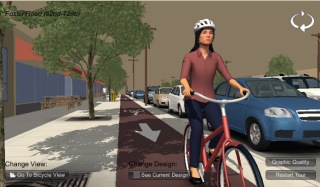
of SE Foster Road by Spencer Boomhower.
Portland resident, citizen activist, and animation expert Spencer Boomhower is at it again. You might remember Spencer’s fantastic animation work that deftly explained the “Idaho Stop” law, or his video for PBOT explaining cycle tracks and buffered bike lanes. Spencer also aided the Columbia River Crossing discussion by producing several helpful animated videos about various design options and issues surrounding the project.
Now Spencer has outdone himself by combining his graphic and explanatory skills with his experience in video game development to produce an interactive visualization of design options under consideration for SE Foster Road. Due to some issues with the display of the Unity3D file format used to create the visualization, what I’ve pasted below is a video version Spencer created for folks who aren’t able to download and display the required plug-ins.
I strongly recommend viewing the animation in its native format via the FosterUnited.org website (you will likely have to download the Unity3D player plugin to view it). In the Unity3D viewer, you can manipulate the perspective and take a self-guided tour of the design options and issues surrounding SE Foster Road project.
The tour includes detailed and accurate views of what the road currently looks like (including its hazards like other vehicle traffic, door zones, and so on), as well as what it would look (and feel) like with a conventional bike lane and a dedicated cycle track.
Spencer’s work gives everyone the chance to learn and understand the options for this project at a whole new level. It’s almost better than actually going out to Foster and experiencing it yourself!
Here are a few more screenshots…


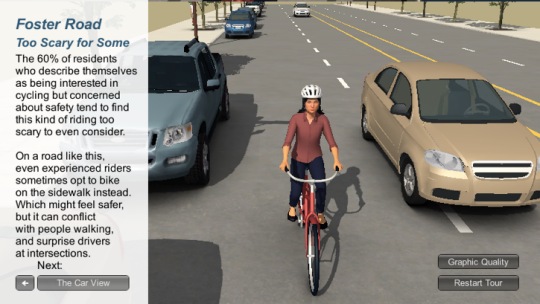

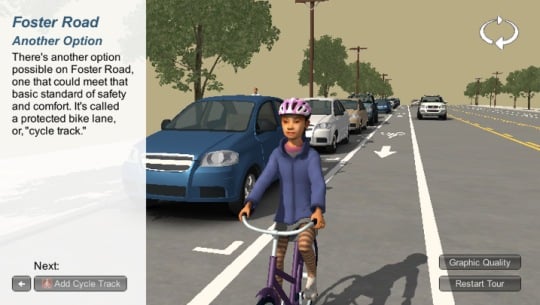
— For more coverage of SE Foster Road and the Foster Road Streetscape Plan, browse our archives.

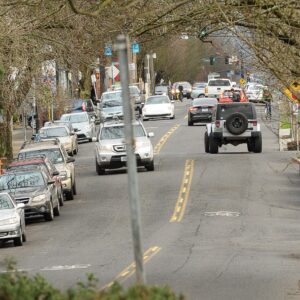
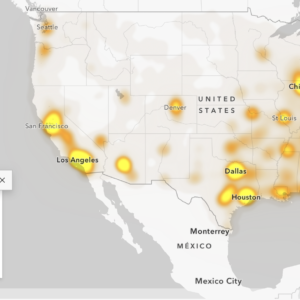


Thanks for reading.
BikePortland has served this community with independent community journalism since 2005. We rely on subscriptions from readers like you to survive. Your financial support is vital in keeping this valuable resource alive and well.
Please subscribe today to strengthen and expand our work.
The cycle track option featured here is still a long shot!
So far PBOT’s best official option for bicyclists is the 3 Lanes + bike lanes as shown in the animation, but I think it’s worth exploring what it would take to get a real cycle track on the street.
We know It would be much more expensive to build a cycle track, but we also know it will serve many more neighborhood residents.
Nice, I remember hearing multiple residents of your neighborhood who were against the cycletrack option due to losing sidewalk space (which they said was big plus of the street for them). Do you think you could sway these folks, as a cycletrack would reduce a substantial portion of the sidewalk for pedestrians/oudoor seating/etc.?
The original PBOT cycle track proposal would have routed bicyclists onto the existing sidewalk, and most people reacted negatively to that.
This proposal is different, extending the curb to create new space for the cycle track. In this design the sidewalks would basically stay the same size as they are today.
Last I heard, PBOT was going to work up some cost numbers for this new and improved cycle track proposal so that we could give it fair consideration.
Even if the curb were extended to make room for a cycletrack, what would discourage people on foot from obliviously strolling along/across it? Tactile strip? Differing height? More than just paint, oh please oh please.
Any and all of the above? Putting the cycle track at a lower level is probably the best solution so that it is clear someone has stepped off of the sidewalk. Cully Blvd is a good example of using planted zone to separate the sidewalk from the bikeway – no one is going to accidentally stumble into that.
If a cycle track is selected I’m sure there will be many months of figuring out the design details.
“…Last I heard, PBOT was going to work up some cost numbers for this new and improved cycle track proposal so that we could give it fair consideration.” Nick Falbo
Assuming PBOT follows through with the numbers, that’s progress. There at least should be some solid sense of what the cost may be before deciding to throw an option out because it’s guessed to be too expensive.
The screen shots accompanying this story look great…nice work Boomhower. Hope to soon get to a computer where I can see the animation. One way or another, I suppose it’s a difficult decision for the city and the neighborhood to make, but a cycle track as shown in the third picture down from the top looks like it could be a great to use.
“We know It would be much more expensive to build a cycle track, but we also know it will serve many more neighborhood residents.”
How do we know this? I can’t think of a single example of a large increase in mode share associated with a program of cycle track construction. The buffered bike lane is, IMO, the best bang for the buck solution in this context. It’s also a safer option given the many intersections along Foster.
The sense in which a cycle track would serve many more neighborhood residents, is that this type of bike infrastructure seems to be closer to that which people apprehensive about riding out in the main lanes with motor vehicle traffic right beside them…would feel more at ease riding upon.
On a cycle track, people riding bikes would have little need to worry about a motor vehicle sweeping up running into them from behind. Less need to worry about right hooks, especially if curbside motor vehicle parking is held two car lengths back from intersections.
If a cycle track somehow managed to be built on Foster, whether people would actually ride it in greater numbers than standard style bike lanes established on the road, remains to be seen.
If we build a regular bike lane, I can guarantee you that many people will continue to ride on the sidewalk. Take a look at any of the big arterial streets near and past 82nd, and you will see bike lanes all over the place. What you wont see is people using those bike lanes. They are riding sidewalk because it feels safer than a strip of paint next to fast cars.
Buffered bike lanes may be able to change this dynamic slightly, but I don’t think they’ll be as successful as a cycle track at either serving the riders that are there today or at attracting new ones.
With all due respect you were stating speculation as fact. German cities showed the largest increases in mode share in Europe largely based on programs of bike lane and bike boulevard expansion. Does this sound familiar?
Danish style cycletracks are very similar to a buffered bike lane. I would support this kind of facility here. Nevertheless, I am not a fan of the meandering bike sidewalks PBOT has built at Cully or Moody. I would much rather see an 8-9 foot buffered bike lane than a narrow path that twists and turns and dumps you out in an intersection at an angle. One of the reasons that cycling mode share is high in europe is because it’s more efficient and convenient than other options. Building disconnected facilities that require transportation cyclists to ride slowly and cautiously is not the best way to increase mode share.
I don’t want the cycle track you described either. I agree that building bad cycle tracks is bad practice. America’s first flirting with cycle tracks in the 70s left such a bad taste in our mouths that we spent the next 20 years in a dark ages of wide outside lanes. The last thing I want is to repeat that mistake.
Great animation. It does however fail to address a major issue that many have with protected cycletracks: it does not show one going through an intersection, where the highest probability of being hit by a car remains (and some would argue is actually increased from a more visible on street bike lane).
Glad you liked it, davemess!
And you bring up a good point about the intersections. You can’t have a complete discussion about cycle tracks without talking about intersections. I wanted to do them in this simulation, but was limited by time constraints to just the cross-section comparisons. That’s part of why Nick timed his excellent and thorough post on intersections to come out at the same time:
http://www.activerightofway.org/p/cycle-tracks-what-about-the-intersections/
I feel like a real examination would show you’re better protected from right hooks on a cycle track than on a bike lane, as long as the design is right. Like if there were a line of cars blocking view of the bike, that would be bad. But basic cycle track design avoids that problem.
This came up when I did an animation for the Broadway cycle track; I started off laying out the street model in 3D with just such a line of parked cars blocking the view of the cycle track. But the City engineer working on the project pointed out my error, saying that there would actually be two parking places removed from near the intersection in order to avoid this problem. So I removed the parking places in my 3D model:
http://screencast.com/t/7wGbhY4c8B
If I could play through that intersection in this new simulation, I think I would feel (and actually be in real life) safer on the cycle track because a right-hook on a bike lane can happen so fast, almost like with getting doored. The car’s width + shy zone of buffer between the car travel lane would seem to offer a lot more chance for people in bikes and cars to see each other, and allow for more reaction time.
Two car lengths is insufficient given a 12-15 mph cycling speed and the angled view of the approaching motorist. The dutch and danes avoid building cycle tracks hemmed in by parked cars because they are generally agreed to be less safe. Given my harrowing near misses on the Broadway cycle track, I would agree,
There are real concerns about how cycle tracks handle intersections. Here are some design options to make the visibility as good as in a bike lane:
http://www.activerightofway.org/p/cycle-tracks-what-about-the-intersections/
Losing sidewalk space is part of why I’m not a fan of the originally proposed cycletrack design on Foster Road… but it looks like this design is based on extending the sidewalk. PBOT has said moving the curb would necessitate relocating utilities and would be very expensive. The other reason it would be difficult to implement is that it would need to swing out towards the roadway at every driveway and intersection to improve the visibility of bicyclists (according to PBOT). I’ve never seen a good map of how often that would need to happen, but just looking at the map, it would be quite frequent, creating somewhat of a slalom course. I know auto parking is sacred to some, but it seems like a lot could be solved by removing parking on one side of the road.
“a lot could be solved by removing parking on one side of the road.”
Removing the center turn late would provide as much space, though removing parking would also have the benefit of more visibility of bikes at intersections. Removing parking at intersections but having a turn lane, and removing the center lane between intersections, would be a great solution to provide enough space for proper buffered bike lanes or cycletracks.
The parking analysis showed that (outside of a few specific spots) parking was vastly underutilized on much of Foster. This is my same experience when I ride down the street during off hours (I don’t take it during peak times).
So I think the SAC knows this, and it sounded like to me they were already plan to reduce parking in a number of areas.
And Joseph, the only thing this is possibly making the lane reduction palatable to most is having 3 lanes. I don’t think this street vamp would have a prayer with a reduction to 2.
“The other reason it would be difficult to implement is that it would need to swing out towards the roadway at every driveway…”
I’ve rode a few cycletracks in europe and I don’t recall one that curved every block. just sayin’
What I see from this animation looks a lot bikes being forced to ride on a glorified sidewalk. I envision cycletrack frequently beguiled by pedestrians and riders going the wrong direction. Not to mention the risk posed by intersections where, from motorists perspective, bikes will seem to appear out of nowhere from behind parked cars, leading to frequent collisions.
I’ll take a wide and/or buffered on-street bike lane any day. Leave the expensive, convoluted, and hazardous cycletracks for the Europeans.
You may prefer a wide bike lane on Foster over other designs, but most of my neighbors wouldn’t dare ride in a bike lane next to fast moving traffic.
If our goal as a city is to encourage bicycling by everyone, we are going to need to build facilities that everyone wants to use. Bike lanes on multilane streets are not that facility.
Good cycle tracks are not sidewalks. They don’t carry the same risks, and every concern you have is a design problem that has been solved.
I would like to see some research on whether our neighbors would really ride on a cycletrack over a buffered bike lane.
Portland bike policy-wonk community needs to create a distinction in cycletrack definition between neighborhood use for short jaunts and kids going to school vs bikeways which allow for cross-town commuting. All this discussion of cycletracks leaves me with an image of a congested ad-hoc space with skateboarders, dog-walkers, and joggers competing for limited space as much as cycle-commuters, kids riding to school, and grocery-getters. If these tracks are successful (more people use them), then the average cycle speed will be set by the slowest users on them, and passing to get somewhere at commuting speeds will be difficult – especially if they are two-way tracks. I see a need to focus the future bike infrastructure plan into these two groupings: high speed, cross-town (inter-neighborhood) commuting as one focus; low-speed, Euro-style, neighborhood paths as the other. If the goal is to get people onto their bikes for health and good community living, then Euro-style cycle tracks are fine. If the goal is to get people out of their single-occupancy cars in order to reduce rush-hour traffic congestion in the Portland metro area, then cycletracks are probably not going to be the best option. I don’t see a compelling case where these two ideas can be merged, effectively, in affordable and realistic retro-fit cycletracks. Is it safety/livability or is it transportation? Once the city enginners an effective intersection crossing at every cross street, deals with the parking and the road diet, and enhanced pedestrian safety that will accompany any change to this section of Foster, this cycletrack on will be pretty slow for someone looking to travel the distance, but it will be great for someone looking to go 3 blocks to the store or to school.
If the city builds cycletracks as they are described above, they will never put up any signage that specifically prohibts use of the space by non-cycling activities. They may try to discourage it with some techniques and branding, but it won’t work in this town to keep non-cyclers off the track, and the bike-backlash will say you can’t exclude users from public spaces. In Europe, people don’t walk and hangout on cycletracks, but here they will be put to use by all sorts of users making them a less viable option for folks looking to have a quick and simple commute of more than one mile. Commuters will stick to the road and want a bike lane, and other users want the expanded sidewalk/cyclepath.
Ironically, meandering bike sidewalks hemmed in by a wall of parked vehicles are are rare in europe. IMO, we should build a buffered bike lane or find the money to build a CPH-style cycle track.
Notice the absence of parked cars and the clear view at an intersection:
http://www.international.fhwa.dot.gov/pubs/pl10010/images/figure20.jpg
+1. Also note the different appearance and texture of the bike lane from the car lane, and the embedded concrete strip. Both serve to separate the lanes tactilely as well as visually.
Come check out the cycletrack/MUP in N. Portland in the Port of Portland that runs to Kelly Pt Park on N Lombard in Rivergate. It’s part of the 40-mile loop. This MUP was put in just a few years ago, and it has the style of a buffered cycletrack (about 15′ away from the road it parallels and buffered by plantings) that bumps back out to the road at each cross-street intersection. When the track comes back out to the corner to cross the side street, the cyclist is put an angle (45 deg) to the road the path parallels. This creates total confusion about right of way and which direction the path user is heading (are they crossing the side street or the main street?). Trucks/semitractors travel this road about >45 mph with heavy loads. When a vehicle wants to turn onto the side street, and if the cyclist is approaching the side street to cross it, the cyclist has right of way. But, the cyclist is coming out of a deep buffered area (poorly visible to the parallel traffic) and approaching at an odd angle so the turning vehicle traffic has to decide what the cyclist is trying to do, and then also decide who has the right of way (there are no signs posted – I checked with the city when these were put in and the cyclist has the right of way and are not required to stop to cross the side street). It becomes a game of chicken with trucks about the right-hook and whether the cyclist will stop or not. It’s a terrible design. Not to mention the curb cut traction coasters are slippery when wet and the cyclist has to negotiate a partial turn as they are trying to go straight across the side-street. If you ride this on a Sunday morning, you may not get the feel of the traffic, but try it on a weekday morning. This cycletrack is only a few years old, and the design is very poor. Seems like this track mostly gets used by maintenance guys to park their trucks on and most cyclists still use the roadway.
Now on Foster, add pedistrians, kids on bicyles, skateboarders, dudes pushing shopping carts, recycle bins, driveways, street parking, sidewalk cafe seating, pedestrian refuges and bump outs at every intersection, tree plantings, utility poles easements, and much more dense use, and it’s hard to imagine an effictive design that is simply about cycling transportation, and not about all of these other uses. If they build it like this, many cyclists will still prefer the roadway. Downtown, great – no problem. Rivergate industrial area, great, just do it right. But, Foster and other dense arterials in mixed use residential/commercial areas have a lot of other interests that will compete for this space, too.
Bike lanes on the street AND wider sidewalks.
Great proposal!
My comments:
1) The parking strip next to the cycle track should have a bulb-out to continue the sidewalk on the other side of the cycle track for the width of the car; this would provide a pedestrian refuge between the cycle track and the motor vehicle lanes, as well as a clear space where drivers could see cyclists about to enter the intersection, perhaps helping to prevent right-hooks.
2) The paint of the cycle track should continue all the way across every intersection.
3) What about combining this design with replacing traffic lights with traffic circles? This could allow, potentially, for the center turn lane to be eliminated, which could have pluses and minuses — more ROW for other purposes (additional trees, wider sidewalks, right-turn lanes…?), though it would require left-turns to go make a U-turn around the traffic circle and come back to make a right turn.
There are a ton of businesses along foster, and cars make left turns in many places other than the main intersections (there are also a lot of more minor streets off Foster). Thus it is unlikely the third lane will be eliminated.
I just hope traffic does not back up like the two lane section from 124th to 150th area.